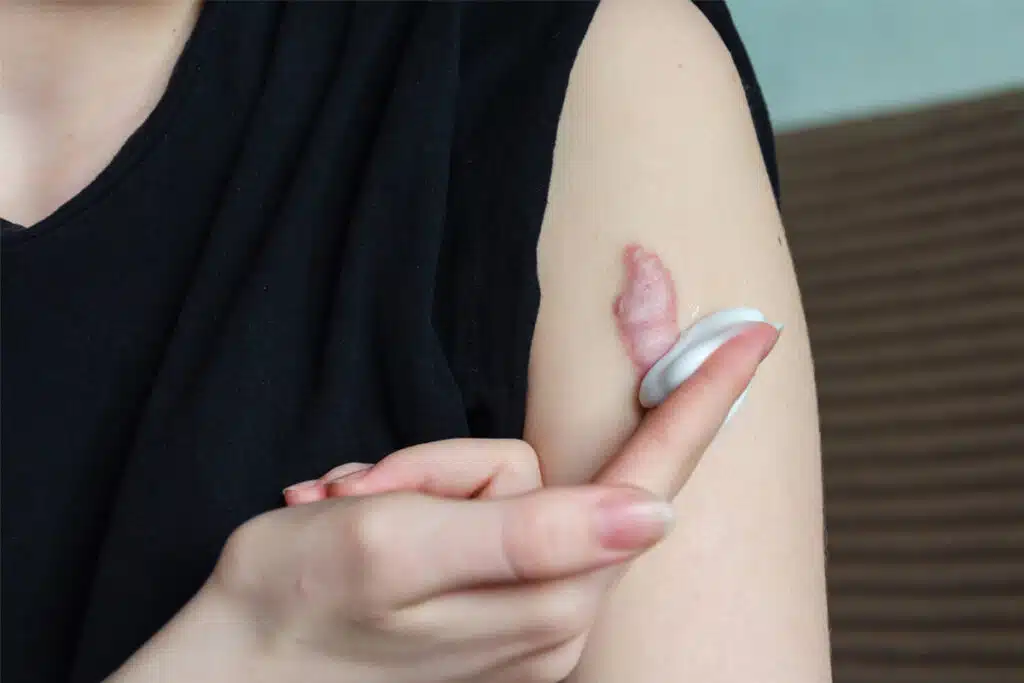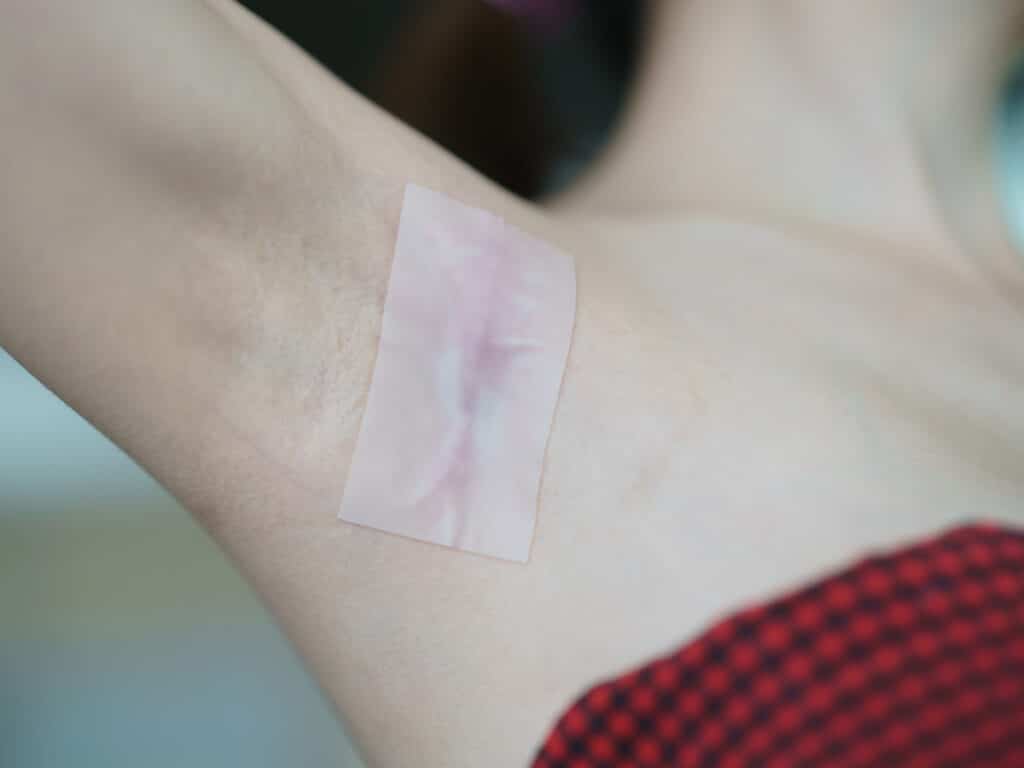Keloid scars, those raised and annoying skin rashes, can be a source of discomfort and self-consciousness. If you or a loved one is dealing with excessive scarring, it’s time to explore solutions. In this article, we will guide you through step-by-step instructions on how to reduce the appearance of keloid scars. Dr. Mendez and Dr. Salloum, specialists in keloids and medical treatments, have contributed their expertise to provide you with a comprehensive understanding of this issue.

Understanding Keloid Scars
Keloids are fibrous tissue that forms after a skin trauma. Unlike normal scarring, they extend beyond the original wound, often due to genetic factors.
Furthermore, keloid scars can be particularly itchy and painful. This discomfort can affect your daily life. By gaining a deeper understanding of keloid formation, you can take proactive steps to manage both their physical appearance and the associated discomfort effectively.
Types of Keloid Scars
Keloids can take various forms, including linear, nodular, and widespread. Recognizing the type of scar you have helps determine the most effective treatment. Linear keloids typically form along a wound’s incision line, while nodular keloids are characterized by raised nodules on the skin’s surface.
Keloid vs. Hypertrophic Scars
Keloids and hypertrophic scars are often confused, but they differ in their appearance and treatment. While hypertrophic scars are raised and red, keloids are thicker and extend further. Recognizing this distinction is crucial when determining the most suitable treatment for your scar type.
Causes of Keloid Formation
The overgrowth of scar tissue that produces the formation of keloids can be caused by different types of skin injuries. These include:
- Surgical scars
- Insect bites
- Chickenpox
- Injection sites
- Acne scarring
- Body piercings
- Ear piercings
Certain patients are more prone to developing keloids when they undergo scarring, for example, individuals with darker skin tones, such as African Americans, Latinos, and Asians, have a higher likelihood of developing keloids, with a 15% to 20% increased risk. Exploring these causes and your skin type can help in preventing their development.
The Role of Family History
If keloids run in your family, you may be genetically predisposed to developing them. Understanding your family history can help you take proactive measures. Consider genetic counseling to assess your risk and discuss preventive strategies with a healthcare professional.
The Importance of Early Treatment
Addressing keloid scars early is essential to prevent excessive scarring. Timely intervention can reduce their appearance and minimize the need for surgical removal. Consult a dermatologist as soon as you notice keloid formation to explore treatment options.
Exploring Keloid Treatment Options
There are several treatment options available to reduce scars’ appearance. From silicone gels to keloid compression therapy Miami Beach, explore the range of choices to find what suits you best.
In your quest for keloid removal or reduction, it is important to consider factors such as the size and location of the scar, as well as your personal preferences. Some treatments may be more suitable for larger scars, while others are better for smaller ones. Your medical specialist can help tailor the treatment to your specific needs.
Silicone Gels: A Non-Invasive Approach
Silicone gels are a popular choice for scar management. Learn how to apply them effectively to your keloid scars, promoting optimal healing and reduced scarring.
Silicone sheets work by creating a protective barrier over the scar, which helps retain moisture and flatten the scar tissue. To maximize their effectiveness, it’s crucial to apply them consistently.

Steroid Injections: Targeting Scar Tissue
Steroid injections are effective in flattening severe scarring. Keloid intralesional steroid therapy Miami Beach works by reducing inflammation and preventing excessive scar tissue growth by inhibiting collagen production. Your doctor will administer these injections directly into the keloid to minimize discomfort and promote scar improvement.
Cryotherapy: Freezing Away Scars
Cryotherapy is another effective method for the reduction or removal of keloids. It involves freezing the keloid scar with liquid nitrogen. This process causes the scar tissue to break down and gradually flatten. It is a minimally invasive procedure that can yield promising results, especially for smaller keloids.
Compression Therapy: Applying Pressure
Compression therapy or keloid pressure treatment involves using pressure garments to flatten scars. By applying constant pressure to the keloid scar, compression therapy helps break down excess collagen and promotes better blood flow to the area. This improved circulation can enhance the scar’s healing process, leading to a smoother appearance over time.
Counter Creams: Topical Solutions
Counter creams and ointments can alleviate itching and discomfort caused by keloids. Although they are not a cure, they can be a beneficial addition to proper wound care. Consider seeking products with ingredients such as aloe vera or vitamin E for their soothing properties.
When selecting a cream or ointment, it is essential to take into account your skin type and any potential allergies. It is advised to seek guidance from a professional to ensure that the cream is suitable and safe for your specific skin condition.
Superficial Radiation Therapy
When it comes to minimizing the appearance of scar tissue, targeted keloid radiation is an effective option. This procedure uses beams of low-energy X-ray that are directed at the area of scarring. The radiation works by targeting the healthy tissue surrounding the scar, promoting better healing and reducing the size and discoloration of the keloid.
Lifestyle Choices to Minimize Keloid Appearance
Making specific lifestyle choices, such as minimizing sun exposure and maintaining a balanced diet, can aid in diminishing the visibility of keloids. Practicing measures to shield your skin from UV rays and ensuring proper nutrition can support your body’s innate healing mechanisms.
When to Consider Surgical Removal
In some cases, keloid surgery may be necessary, especially if non-surgical methods prove ineffective. Consult with a specialist to explore this option. Surgical removal involves excising the keloid tissue, but it may increase the rate of recurrence. You can avoid this by combining the surgery with a non-invasive treatment. Your doctor will guide whether this step is suitable for your situation.
Schedule an Appointment with Our Specialists
If you’re struggling with keloids, our specialists, Dr. Mendez and Dr. Salloum, are here to help. They have extensive experience in keloid management and can provide personalized guidance based on your unique situation. Do not wait any longer; take the first step towards smoother, scar-free skin by scheduling an appointment with our experts today.
Remember, keloid scars can be managed effectively without surgery. Explore your options, consult with specialists, and take control of your skin’s appearance.
Now that you have learned how to reduce the appearance of keloid scars without surgery, you can start working towards achieving smoother and scar-free skin. By implementing non-surgical techniques and consulting with professionals as needed, individuals can reduce the visibility of keloids and improve their self-assurance. Take control of your skin’s appearance by not allowing keloids to hinder you.